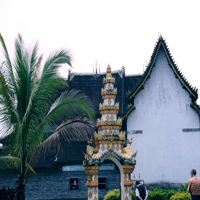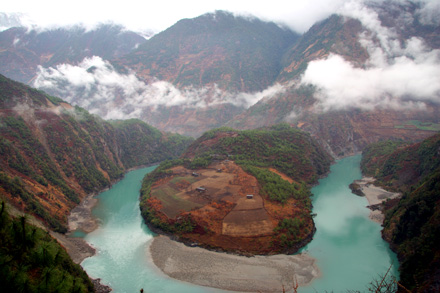Lugu Lake
Overview
-
The Lugu Lake is located 280km north Lijiang, between Yunnan and Sichuan and is known for its peculiar natural scenery and the unique matriarchal culture of the Mosuo people, that it sill upholds today. Women are the leaders of the community’s extensive families. There are neither husbands nor fathers, lovers meet at night but by day they live separately with their own mother’s families. Women also operate production and management, and hold the principal position in the society. This ‘woman’s kingdom’ adds mystique to the place.
Best time to visit
-
The Lugu Lake area is warm in winter and cool during summer, the average monthly temperature is less than 20 degrees Celsius, however, the best time to visit Lu Gu Lake is still spring and summer.
Annual climate averages
The Lake Lugu area has an average annual precipitation of 926 mm, average annual temperature of 8 °C.
How to get there?
-
Distances from Beijing and Shanghai
Lijiang is 2600KM from Beijing
Lijiang is 2400KM from Shanghai
Plane and Train information
Beijing-Lijiang- There is one flight per day from Beijing to Lijiang starting at 07:55. The flight takes 5.5 hours.
Lijiang-Beijing- There is one flight per day from Lijiang to Beijing starting at 08:25. The flight takes 5 hours.Shanghai Hongqiao-Lijiang- There are 2-3 flights per day from Shanghai Hongqiao airport to Lijiang. The fight takes 5 hours.
Lijiang-Shanghai Hongqiao- There are 3 flights per day from Lijiang to Shanghai Hongqiao airport. The flight takes 5 hours.Getting to Lugu Lake
Lugu Lake lies 200 kilometers (approximately 124 miles) from the center of Lijiang City.There are 2 buses per day from Lijiang to Lugu Lake. (07:50;09:00)
What to see
-
Lugu Lake
Lugu Lake is located between Ninglang County in Yunnan Province and Yanyuan County in Sichuan Province, 300 kilometers away from Lijiang County. It is a plateau lake with a total area of 52 square kilometers, 2685 meters above sea level. The average depth is 45 meters, the deepest point being 93 meters. The water is very clear. The lake remains an uncontaminated plateau lake
Scenery: Among the five islands in the lake, three are in the territory of Yunnan and two in that of Sichuan. Heiwawudao, Ligedao are metaphorically called "Three Islands of Ponglai" (Islands of the Immortals). Sitting in the middle of the lake, Heiwawudao Island is also called "the Chieftain Island" because Ashaoyun, the chieftain of Yongning, built his villa on the island in the Guangxu period of the Qing dynasty. Rock, an American scientist, also used to reside on this island. On the south side of the lake stands Liwubidao Island lies at the foot of the Lion Mountain. It is actually a small peninsular formed by the extension of the Lion Mountain into the Lake. A dozen of Mosuo families live on this island so it is possible for the visitors to experience the life on the island and, at the same time, enjoy the beautiful scenery of the lake.
Cultural sites: Many cultural sites and scenic spots are scattered along the lakeside. They are Mosuo villages, plateau hot springs, the underground maze-The Lucky Cave, the Chieftain's Palace, the Zhamei Lamaist Temple, Riyuehe - The Ruins of the Yuan Army Quarters when Kublai Khan was on his south - expansion, yongning - the key town on the ancient tea and horse trading route. Many beautiful legends have been circulating among the people.
Trekking along the lakeside and boating in the lake to enjoy the leisure is perfect to discover the natural beauty of this place.
Explore the matriarchal society by visiting typical Mosuo families and participate in the Musuo youths’ campfire party to witness how they express love to the beloved ones.
Useful Information
-
What to bring
Clothes for cooler evenings even in summer time; sunscreen, a hat and sunglasses for Yunan's high elevation & bright sunshine; and Insect repellent
More Information
-
Food
Salted meat, corn rice, Sulima liquor. The roasted fish is delicious along with the local fruit wine. You have to be careful though, since the sweet wine is very deceitful. Many feel nothing when drinking it, but suddenly find themselves drunk.
Minorities
Mosuo: The Mosuos, a branch of the Naxi nationality with a population of about 15000, are the main ethnic group scattered in the lakeside villages. The Mosuo women wear long hair tied into a bun and red, green and black garments and white folding skirts with colorful sashes tied round their waists. Before 13 years old, they usually wear long gowns. After the initiation ceremony at the age of 13, men wear trousers and women wear skirts.
The Mosuo people have their own ways and customs, still retain some remnants of the matriarchal society. Men and women are not bound by marriage, each living at one's mother's home. Men work at home during the day and spend their night with the women they love in their homes. Children are under the care of and supported by their maternal families. Fathers do not live in the same family with their children and women so that they are not bound up with their women financially in their production and life. This unique wedlock values affection and gives more freedom to men and women in their relationships. They may choose to unite or separate at will. It has been considered as the living fossil as a basis for a study of social patterns and matriarchal marriage customs in today' s world.
Festivals
The Zhuanshan Festival (the Festival of Turning - around the Mountain) which falls on 25th July of the lunar year is the traditional festival of the Mosuo people. On that day they would dress in their Sunday best to worship the Gemu Goddess Mountain (the Lion Mountain) and pray for the Goddess' protection. It is also a time for horse racing, wrestling and antiphonal sining. The young people take the chance to search for their lovers, whom they call Axia.


 Off-the-Beaten Path Dali, Lijiang & Shangri-La of Yunnan
Off-the-Beaten Path Dali, Lijiang & Shangri-La of Yunnan Western Yunnan's Tengchong - Volcanoes & Hot Springs
Western Yunnan's Tengchong - Volcanoes & Hot Springs Off-the-beaten Dali -Rural life and Minorities of Yunnan
Off-the-beaten Dali -Rural life and Minorities of Yunnan Nujiang Gorge in Northwest Yunnan
Nujiang Gorge in Northwest Yunnan Yunnan's Yuanyang (Hani Rice Terrace) & Tropical Xishuangbanna
Yunnan's Yuanyang (Hani Rice Terrace) & Tropical Xishuangbanna



